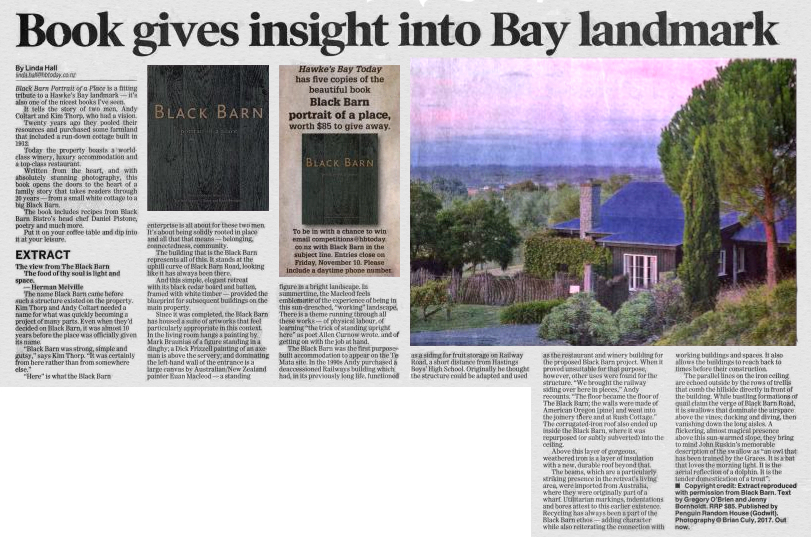Book gives insight into Bay Landmark
By Linda Hall
linda.hall[@]hbtoday.co.nz
Black Barn Portrait of a Place is a fitting tribute to a Hawke’s Bay landmark – it’s also one of the nicest books I’ve seen.
It tells the story of two men, Andy Coltart and Kim Thorp, who had a vision.
Twenty years ago they pooled their resources and purchased some farmland that included a run-down cottage built in 1912.
Today the property boasts a world-class winery, luxury accommodation and a top-class restaurant.
Written from the heart, and with absolutely stunning photography, this book opens the doors to the heart of a family story that takes readers through 20 years – from a small white cottage to a big Black Barn.
The book includes recipes from Black Barn Bistro’s head chef Daniel Pistone, poetry and much more.
Put it on your coffee table and dip into it at your leisure.
EXTRACT
The view from The Black Barn
The food of thy soul is light and space.
– Herman Melville
The name Black Barn came before such a structure existed on the property. Kim Thorp and Andy Coltart needed a name for what was quickly becoming a project of many parts. Even when they’d decided on Black Barn, it was almost 10 years before the place was officially given its name.
“Black Barn was strong, simple and gutsy,” says Kim Thorp. “It was certainly from here rather than from somewhere else.”
“Here” is what the Black Barn enterprise is all about for these two men. It’s about being solidly rooted in place and all that that means belonging connectedness, community.
The building that is the Black Barn represents all of this. It stands at the uphill curve of Black Barn Road, looking like it has always been there.
And this simple, elegant retreat – with its black cedar board and batten, framed with white timber provided the blueprint for subsequent buildings on the main property.
Since it was completed, the Black Barn has housed a suite of artworks that feel particularly appropriate in this context. In the living room hangs a painting by Mark Braunias of a figure standing in a dinghy; a Dick Frizzell painting of an axeman is above the servery; and dominating the left-hand wall of the entrance is a large canvas by Australian/New Zealand painter Euan Macleod – a standing figure in a bright landscape. In summertime, the Macleod feels emblematic of the experience of being in this sun-drenched, “working” landscape. There is a theme running through all these works – of physical labour, of learning “the trick of standing upright here” as poet Allen Curnow wrote, and of getting on with the job at hand.
The Black Barn was the first purpose-built accommodation to appear on the Te Mata site. In the 1990s Andy purchased a deaccessioned Railways building which had, in its previously long life, functioned as a siding for fruit storage on Railway Road, a short distance from Hastings Boys’ High School. Originally he thought the structure could be adapted and used as the restaurant and winery building for the proposed Black Barn project. When it proved unsuitable for that purpose, however, other uses were found for the structure. “We brought the railway siding over here in pieces,” Andy recounts. “The floor became the floor of The Black Barn; the walls were made of American Oregon [pine] and went into the joinery there and at Rush Cottage.” The corrugated-iron roof also ended up inside the Black Barn, where it was repurposed (or subtly subverted) into the ceiling.
Above this layer of gorgeous, weathered iron is a layer of insulation with a new, durable roof beyond that.
The beams, which are a particularly striking presence in the retreat’s living area, were imported from Australia, where they were originally part of a wharf. Utilitarian markings, indentations and bores attest to this earlier existence. Recycling has always been a part of the Black Barn ethos – adding character while also reiterating the connection with working buildings and spaces. It also allows the buildings to reach back to times before their construction.
The parallel lines on the iron ceiling are echoed outside by the rows of trellis that comb the hillside directly in front of the building. While bustling formations of quail claim the verge of Black Barn Road, it is swallows that dominate the airspace above the vines; ducking and diving, then vanishing down the long aisles. A flickering, almost magical presence above this sun-warmed slope, they bring to mind John Ruskin’s memorable description of the swallow as “an owl that’ has been trained by the Graces. It is a bat that loves the morning light. It is the aerial reflection of a dolphin. It is the tender domestication of a trout”.
Copyright credit: Extract reproduced with permission from Black Barn. Text by Gregory O’Brien and Jenny Bornholdt. RRP $85. Published by Penguin Random House (Godwit). Photography © Brian Culy, 2017. Out now.












Do you know something about this record?
Please note we cannot verify the accuracy of any information posted by the community.